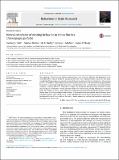Files in this item
Neural correlates of nesting behavior in zebra finches (Taeniopygia guttata)
Item metadata
| dc.contributor.author | Hall, Zachary J. | |
| dc.contributor.author | Bertin, Marion | |
| dc.contributor.author | Bailey, Ida E. | |
| dc.contributor.author | Meddle, Simone L. | |
| dc.contributor.author | Healy, Susan D. | |
| dc.date.accessioned | 2014-04-11T12:01:03Z | |
| dc.date.available | 2014-04-11T12:01:03Z | |
| dc.date.issued | 2014-05-01 | |
| dc.identifier | 109817254 | |
| dc.identifier | b98568bb-fb10-416a-9702-d1979e1f18b7 | |
| dc.identifier | 84896694636 | |
| dc.identifier | 000333853300004 | |
| dc.identifier.citation | Hall , Z J , Bertin , M , Bailey , I E , Meddle , S L & Healy , S D 2014 , ' Neural correlates of nesting behavior in zebra finches ( Taeniopygia guttata ) ' , Behavioural Brain Research , vol. 264 , pp. 26-33 . https://doi.org/10.1016/j.bbr.2014.01.043 | en |
| dc.identifier.issn | 0166-4328 | |
| dc.identifier.other | ORCID: /0000-0002-8059-4480/work/60631240 | |
| dc.identifier.uri | https://hdl.handle.net/10023/4565 | |
| dc.description | Open Access funded by Biotechnology and Biological Sciences Research Council. | en |
| dc.description.abstract | Nest building in birds involves a behavioral sequence (nest material collection and deposition in the nest) that offers a unique model for addressing how the brain sequences motor actions. In this study, we identified brain regions involved in nesting behavior in male and female zebra finches (Taeniopygia guttata). We used Fos immunohistochemistry to quantify production of the immediate early gene protein product Fos (a molecular indicator of neuronal activity) in the brain correlated this expression with the variation in nesting behavior. Using this technique, we found that neural circuitry involved in motor sequencing, social behavior, reward and motivation were active during nesting. Within pairs of nesting birds, the number of times a male picked up or deposited nesting material and the amount of time a female spent in the nest explained the variation in Fos expression in the anterior motor pathway, social behavior network, and reward neural circuits. Identification of the brain regions that are involved in nesting enables us to begin studying the roles of motor sequencing, context, and reward in construction behavior at the neural level. | |
| dc.format.extent | 8 | |
| dc.format.extent | 921422 | |
| dc.language.iso | eng | |
| dc.relation.ispartof | Behavioural Brain Research | en |
| dc.subject | Nesting behavior | en |
| dc.subject | Nest building | en |
| dc.subject | C-fos | en |
| dc.subject | Anterior motor pathway | en |
| dc.subject | Zebra finch | en |
| dc.subject | QH301 Biology | en |
| dc.subject | BDC | en |
| dc.subject | R2C | en |
| dc.subject.lcc | QH301 | en |
| dc.title | Neural correlates of nesting behavior in zebra finches (Taeniopygia guttata) | en |
| dc.type | Journal article | en |
| dc.contributor.sponsor | BBSRC | en |
| dc.contributor.institution | University of St Andrews. School of Biology | en |
| dc.contributor.institution | University of St Andrews. School of Psychology and Neuroscience | en |
| dc.contributor.institution | University of St Andrews. Centre for Biological Diversity | en |
| dc.contributor.institution | University of St Andrews. Centre for Social Learning & Cognitive Evolution | en |
| dc.contributor.institution | University of St Andrews. Institute of Behavioural and Neural Sciences | en |
| dc.identifier.doi | 10.1016/j.bbr.2014.01.043 | |
| dc.description.status | Peer reviewed | en |
| dc.identifier.grantnumber | BB/I019502/1 | en |
This item appears in the following Collection(s)
Items in the St Andrews Research Repository are protected by copyright, with all rights reserved, unless otherwise indicated.

